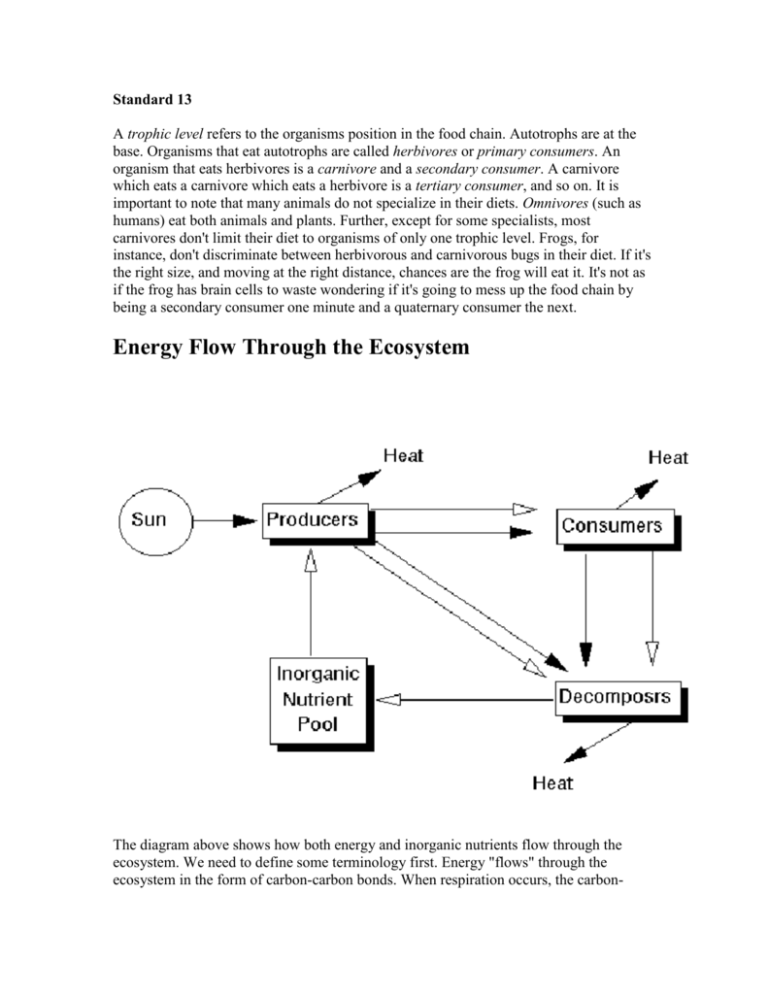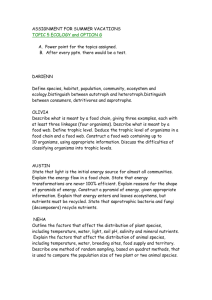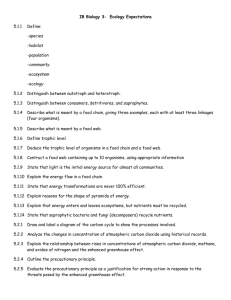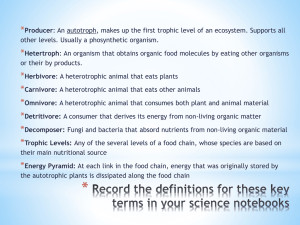A trophic level refers to the organisms position in the food chain
advertisement

Standard 13 A trophic level refers to the organisms position in the food chain. Autotrophs are at the base. Organisms that eat autotrophs are called herbivores or primary consumers. An organism that eats herbivores is a carnivore and a secondary consumer. A carnivore which eats a carnivore which eats a herbivore is a tertiary consumer, and so on. It is important to note that many animals do not specialize in their diets. Omnivores (such as humans) eat both animals and plants. Further, except for some specialists, most carnivores don't limit their diet to organisms of only one trophic level. Frogs, for instance, don't discriminate between herbivorous and carnivorous bugs in their diet. If it's the right size, and moving at the right distance, chances are the frog will eat it. It's not as if the frog has brain cells to waste wondering if it's going to mess up the food chain by being a secondary consumer one minute and a quaternary consumer the next. Energy Flow Through the Ecosystem The diagram above shows how both energy and inorganic nutrients flow through the ecosystem. We need to define some terminology first. Energy "flows" through the ecosystem in the form of carbon-carbon bonds. When respiration occurs, the carbon- carbon bonds are broken and the carbon is combined with oxygen to form carbon dioxide. This process releases the energy, which is either used by the organism (to move its muscles, digest food, excrete wastes, think, etc.) or the energy may be lost as heat. The dark arrows represent the movement of this energy. Note that all energy comes from the sun, and that the ultimate fate of all energy in ecosystems is to be lost as heat. Energy does not recycle!! The other component shown in the diagram are the inorganic nutrients. They are inorganic because they do not contain carbon-carbon bonds. These inorganic nutrients include the phosphorous in your teeth, bones, and cellular membranes; the nitrogen in your amino acids (the building blocks of protein); and the iron in your blood (to name just a few of the inorganic nutrients). The movement of the inorganic nutrients is represented by the open arrows. Note that the autotrophs obtain these inorganic nutrients from the inorganic nutrient pool, which is usually the soil or water surrounding the plants or algae. These inorganic nutrients are passed from organism to organism as one organism is consumed by another. Ultimately, all organisms die and become detritus, food for the decomposers. At this stage, the last of the energy is extracted (and lost as heat) and the inorganic nutrients are returned to the soil or water to be taken up again. The inorganic nutrients are recycled, the energy is not. Many of us, when we hear the word "nutrient" immediately think of calories and the carbon-carbon bonds that hold the caloric energy. IT IS VERY IMPORTANT that you be careful in your use of the word nutrient in this sense. When writing about energy flow and inorganic nutrient flow in an ecosystem, you must be clear as to what you are referring. Unmodified by "inorganic" or "organic", the word "nutrient" can leave your reader unsure of what you mean. This is one case in which the scientific meaning of a word is very dependent on its context. Another example would be the word "respiration", which to the layperson usually refers to "breathing", but which means "the extraction of energy from carbon-carbon bonds at the cellular level" to most scientists (except those scientists studying breathing, who use respiration in the lay sense). To summarize: In the flow of energy and inorganic nutrients through the ecosystem, a few generalizations can be made: 1. The ultimate source of energy (for most ecosystems) is the sun 2. The ultimate fate of energy in ecosystems is for it to be lost as heat. 3. Energy and nutrients are passed from organism to organism through the food chain as one organism eats another. 4. Decomposers remove the last energy from the remains of organisms. 5. Inorganic nutrients are cycled, energy is not. Food Chains and Webs: A food chain is the path of food from a given final consumer back to a producer. For instance, a typical food chain in a field ecosystem might be: grass ---> grasshopper --> mouse ---> snake ---> hawk Note that even though I said the food chain is the path of food from a given final consumer back to a producer we typically list a food chain from producer on the left (or at the bottom) to final consumer on the right (or at the top). Note to international readers: In Hebrew or Aramaic, or other languages which are read right-to-left, is it customary to list the food chains in the reverse order? By the way, you should be able to look at the food chain above and identify the autotrophs and heterotrophs, and classify each as a herbivore, carnivore, etc. You should also be able to determine that the hawk is a quaternary consumer. The real world, of course, is more complicated than a simple food chain. While many organisms do specialize in their diets (anteaters come to mind as a specialist), other organisms do not. Hawks don't limit their diets to snakes, snakes eat things other than mice, mice eat grass as well as grasshoppers, and so on. A more realistic depiction of who eats whom is called a food web; an example is shown below: It is when we have a picture of a food web in front of us that the definition of food chain makes more sense. We can now see that a food web consists of interlocking food chains, and that the only way to untangle the chains is to trace back along a given food chain to its source. The food webs you see here are grazing food chains since at their base are producers which the herbivores then graze on. While grazing food chains are important, in nature they are outnumbered by detritus-based food chains. In detritus-based food chains, decomposers are at the base of the food chain, and sustain the carnivores which feed on them. In terms of the weight (or biomass) of animals in many ecosystems, more of their body mass can be traced back to detritus than to living producers. Pyramids The concept of biomass is important. It is a general principle that the further removed a trophic level is from its source (detritus or producer), the less biomass it will contain (biomass here would refer to the combined weight of all the organisms in the trophic level). This reduction in biomass occurs for several reasons: 1. not everything in the lower levels gets eaten 2. not everything that is eaten is digested 3. energy is always being lost as heat It is important to remember that the decrease in number is best detected in terms or biomass. Numbers of organisms are unreliable in this case because of the great variation in the biomass of individual organisms. For instance, squirrels feed on acorns. The oak trees in a forest will always outnumber the squirrels in terms of combined weight, but there may actually be more squirrels than oak trees. Remember that an individual oak tree is huge, weighing thousands of kilograms, while an individual squirrel weighs perhaps 1 kilogram at best. There are few exceptions to the pyramid of biomass scheme. One occurs in aquatic systems where the algae may be both outnumbered and outweighed by the organisms that feed on the algae. The algae can support the greater biomass of the next trophic level only because they can reproduce as fast as they are eaten. In this way, they are never completely consumed. It is interesting to note that this exception to the rule of the pyramid of biomass also is a partial exception to at least 2 of the 3 reasons for the pyramid of biomass given above. While not all the algae are consumed, a greater proportion of them are, and while not completely digestible, algae are far more nutritious overall than the average woody plant is (most organisms cannot digest wood and extract energy from it). A generalization exists among ecologists that on average, about 10% of the energy available in one trophic level will be passed on to the next; this is primarily due to the 3 reasons given above. Therefore, it is also reasonable to assume that in terms of biomass, each trophic level will weigh only about 10% of the level below it, and 10x as much as the level above it. It also seems, however, that every time I go to measure, test, or model this assumption I run into an inconsistency, so take this generalization with a big grain of salt. Still, it comes in useful In terms of human diet and feeding the world's population, consider this. If we all ate corn, there would be enough food for 10x as many of us as compared to a world where we all eat beef (or chicken, fish, pork, etc.). Another way of looking at it is this. Every time you eat meat, you are taking food out of the mouths of 9 other people, who could be fed with the plant material that was fed to the animal you are eating. Of course, it's not quite that simple, but you get the general idea. Biological Magnification Biological magnification is the tendency of pollutants to become concentrated in successive trophic levels. Often, this is to the detriment of the organisms in which these materials concentrate, since the pollutants are often toxic. Biomagnification occurs when organisms at the bottom of the food chain concentrate the material above its concentration in the surrounding soil or water. Producers, as we saw earlier, take in inorganic nutrients from their surroundings. Since a lack of these nutrients can limit the growth of the producer, producers will go to great lengths to obtain the nutrients. They will spend considerable energy to pump them into their bodies. They will even take up more than they need immediately and store it, since they can't be "sure" of when the nutrient will be available again (of course, plants don't think about such things, but, as it turns out, those plants, which, for whatever reason, tended to concentrate inorganic nutrients have done better over the years). The problem comes up when a pollutant, such as DDT or mercury, is present in the environment. Chemically, these pollutants resemble essential inorganic nutrients and are brought into the producer's body and stored "by mistake". This is the first step in biomagnification; the pollutant is at a higher concentration inside the producer than it is in the environment. The second stage of biomagnification occurs when the producer is eaten. Remember from our discussion of a pyramid of biomass that relatively little energy is available from one trophic level to the next. This means that a consumer (of any level) has to consume a lot of biomass from the lower trophic level. If that biomass contains the pollutant, the pollutant will be taken up in large quantities by the consumer. Pollutants that biomagnify have another characteristic. Not only are they taken up by the producers, but they are absorbed and stored in the bodies of the consumers. This often occurs with pollutants soluble in fat such as DDT or PCB's. These materials are digested from the producer and move into the fat of the consumer. If the consumer is caught and eaten, its fat is digested and the pollutant moves to the fat of the new consumer. In this way, the pollutant builds up in the fatty tissues of the consumers. Water-soluble pollutants usually cannot biomagnify in this way because they would dissolve in the bodily fluids of the consumer. Since every organism loses water to the environment, as the water is lost the pollutant would leave as well. Alas, fat simply does not leave the body. The "best" example of biomagnification comes from DDT. This long-lived pesticide (insecticide) has improved human health in many countries by killing insects such as mosquitoes that spread disease. On the other hand, DDT is effective in part because it does not break down in the environment. It is picked up by organisms in the environment and incorporated into fat. Even here, it does no real damage in many organisms (including humans). In others, however, DDT is deadly or may have more insidious, long-term effects. In birds, for instance, DDT interferes with the deposition of calcium in the shells of the bird's eggs. The eggs laid are very soft and easily broken; birds so afflicted are rarely able to raise young and this causes a decline in their numbers. This was so apparent in the early 1960's that it led the scientist Rachel Carson to postulate a "silent spring" without the sound of bird calls. Her book "Silent Spring" led to the banning of DDT, the search for pesticides that would not biomagnify, and the birth of the "modern" environmental movement in the 1960's. Birds such as the bald eagle have made comebacks in response to the banning of DDT in the US. Ironically, many of the pesticides which replaced DDT are more dangerous to humans, and, without DDT, disease (primarily in the tropics) claims more human lives. Summary: In order for a pollutant to biomagnify, the following conditions must be met: 1. The pollutant must be long-lived. 2. The pollutant must be concentrated by the producers. 3. The pollutant must be fat-soluble. Human vs. Natural Food Chains Human civilization is dependent on agriculture. Only with agriculture can a few people feed the rest of the population; the part of the population freed from raising food can then go on to do all the things we associate with civilization. Agriculture means manipulating the environment to favor plant species that we can eat. In essence, humans manipulate competition, allowing favored species (crops) to thrive and thwarting species which might otherwise crowd them out (weeds). In essence, with agriculture we are creating a very simple ecosystem. At most, it has only three levels - producers (crops), primary consumers (livestock, humans) and secondary consumers (humans). This means that little energy is lost between tropic levels, since there are fewer trophic levels present. This is good for humans, but what type of "ecosystem" have we created? Agricultural ecosystems have several problems. First, we create monocultures, or fields with only one crop. This is simplest for planting, weeding, and harvesting, but it also packs many similar plants into a small area, creating a situation ideal for disease and insect pests. In natural ecosystems, plants of one species are often scattered. Insects, which often specialize on feeding on a particular plant species, have a hard time finding the scattered plants. Without food, the insect populations are kept in check. In a field of corn however, even the most inept insect can find a new host plant with a jump in any direction. Likewise, disease is more easily spread if the plants are in close proximity. It takes lots of chemicals (pesticides) to keep a monoculture going. Another problem with human agriculture is that we rely on relatively few plants for food. If the corn and rice crops failed worldwide in the same year, we would be hard-pressed to feed everyone (not that we're doing a great job of it now). Natural ecosystems usually have alternate sources of food available if one fails. A final problem associated with agroecosystems is the problem of inorganic nutrient recycling. In a natural ecosystem, when a plant dies it fall to the ground and rots, and its inorganic nutrients are returned to the soil from which they were taken. In human agriculture, however, we harvest the crop, truck it away, and flush it down the toilet to be run off in the rivers to the ocean. Aside from the water pollution problems this causes, it should be obvious to you that the nutrients are not returned to the fields. They have to be replaced with chemical fertilizers, and that means mining, transportation, electricity, etc. Also, the chemical fertilizers tend to run off the fields (along with soil disrupted by cultivation) and further pollute the water. Some solutions are at hand, but they bring on new problems, too. No-till farming uses herbicides to kill plants in a field; the crop is then planted through the dead plants without plowing up the soil. This reduced soil and fertilizer erosion, but the herbicides themselves may damage ecosystems. In many areas, sewage sludge is returned to fields to act as a fertilizer. This reduces the need for chemical fertilizers, but still requires a lot of energy to haul the sludge around. Further, if one is not careful, things such as household chemicals and heavy metals may contaminate the sewage sludge and biomagnify in the crops which we would then eat.








